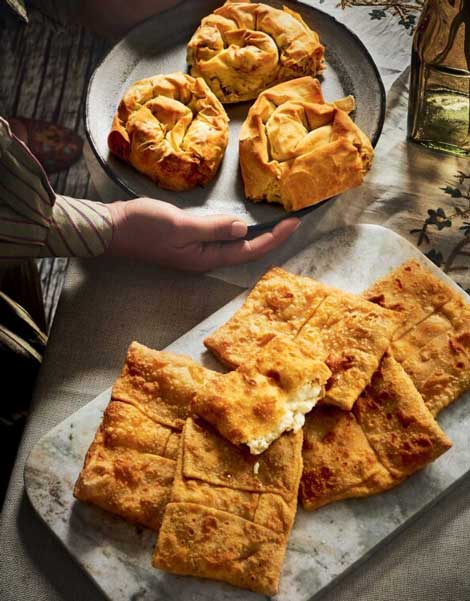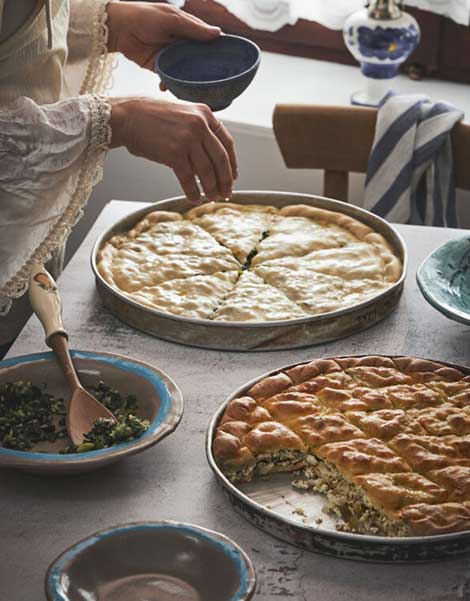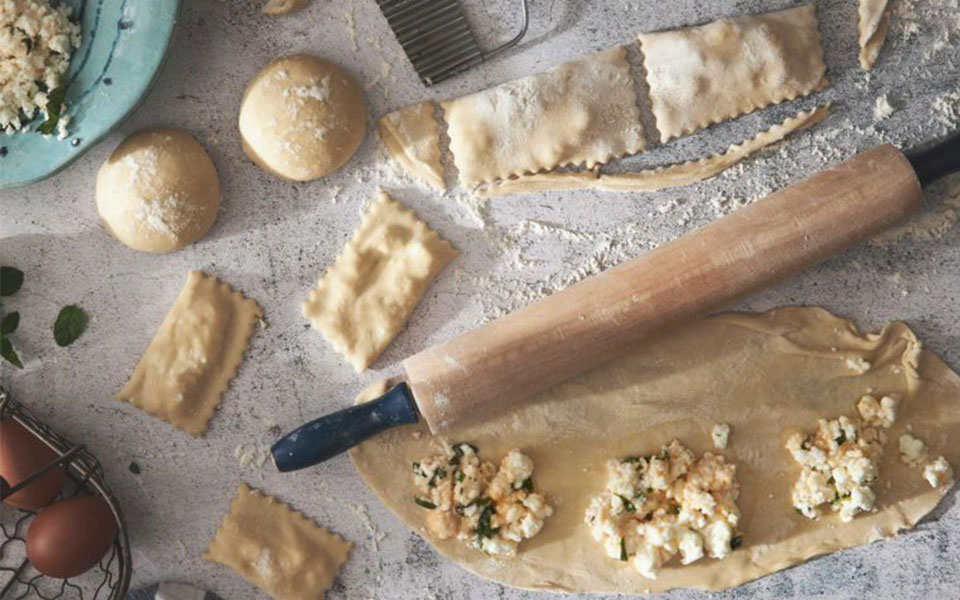Aegean island pies are a part of a cuisine created under blustery circumstances: if islanders were expected to cook based on what the winds bring them, surely they’d have gone hungry. A blessing and a curse, the sea yields an abundance of gifts when it is calm. But when it angers and rebels, it can leave the islanders stranded for days, alone, and left to make do with all they have near – a garden and their animals. It is with these latter essentials that they learned to survive and cook, creating, among many other dishes, a broad array of delicious pies.
If the Aegean were all one pie, it could be the rare ‘atherinopita’ (atherina is a small sand-smelt fish), a fried flour pie ingeniously invented by fishermen from the south. But islanders have concocted dozens of far more elaborate pies, rolling out the pastry like silk sheets, making even higher, fluffier doughs, selecting the greens and savory cheeses, heating up their wood-fired ovens to the max and setting pans onto the fire.
In Mykonos they pride themselves on their onion pie, a variant of which are the fried pies made in Milos with dry cheese, onion and mint. They make pies with greens seasoned with salted lard (pig fat) or ‘sissera’ with lard and other wild greens, which grow in the dry soil of the Windy Island. In northern Lesvos, for the pies, the ‘chortarouses’ (women who went out to the grassy meadows) gathered lapata, kafkalithres, wild dill, milkweed, poppies, myrtle and nettles.
In Ikaria, wild weed pies are called gemostopites and are baked on a clay or stone slab placed in the fireplace. Sometimes they are called cabbage pies and sometimes they contain bulgur wheat or trachana to absorb the juices. In Rhodes, they make pougia (pouches) stuffed with greens, which are cooked on coals in a kiln, in a type of clay pan that’s hard to find these days. They are served with juices from the stuffing greens, which are poured over the pie as soon as it reaches the table. Less complex but extremely tasty are the fried cabbage pies of Karpathos and the sefoukloti pie of Naxos (containing Swiss chard).
The Christmastime, fesklopita from Tinos is a unique, sweet variation of chard pie, containing molasses, sugar, walnuts, raisins and herbs and a pastry kneaded with orange juice, egg and oil. The small pies are fried and then sprinkled with icing sugar.

© Theodosis Georgiadis

© Theodosis Georgiadis
There is a never-ending variety of sweet pies made across the Aegean. In Mykonos and Sifnos they make large honey pies with cheese and thyme honey, in Syros they make an aromatic cheese pie without pastry. With pale goat and sheep’s cheese they make small treats, Santorini’s meletinia and Anafi’s meletiri, while in Tinos, where they make them with petroto “stone” cheese, they call them sweet cheese pies, which are elegant works of art with a lacey, pinched pastry, reminiscent of spring daisies.
Crisp, fried and sweet renditions are masourakia pies of Chios and the psarakia of Tinos. The former type is filled with almond or mastic ipovrihio cream and the latter contains walnuts and honey. Milos’ and Kimolos’ ladenia pie is a special delight. It is made with a dough reminiscent of that used to make pizza and contains plenty of onions, olive oil and local, sundried tomatoes.
Sweet pumpkins grow in the dry, arid soil of Kimolos and Syros and this ingredient stars in Kimolos’ kolokythenies or flaounes and Syros’ pumpkin pies. In Lesvos they make the savory sarikelia with feta and mint. In Ikaria and Chios a similar pie is called tabouropita and small triangular pies containing pumpkin are called trigona pitarakia in Skyros. These are baked in a traditional wood fire oven and also contain graviera cheese, onion, cinnamon, all spice and mint. In the old days, springtime cheeses were the key ingredient in traditional pies, made in tens of different ways.
In Anafi they make yellow zaforiastes cheese pies, in Kimolos they make the open tyrenia, with fresh manouri and raised dough, in Milos and the small Cyclades. In Skopelos they make a cheese pie made with a fine handmade pastry that is twisted and fried, filled with local goat’s mizithra cheese. In Ikaria they make the fouskopita, something between a crepe and fried doughnut which they fill with the local kathoura cheese and green peppers.
This article was previously published in Greek at Kathimerini’s gastronomos.gr.












